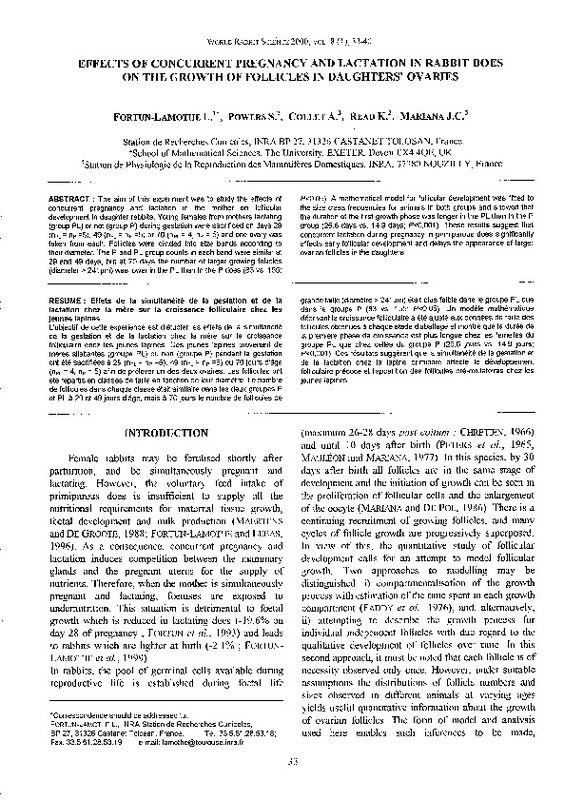JavaScript is disabled for your browser. Some features of this site may not work without it.
Buscar en RiuNet
Listar
Mi cuenta
Estadísticas
Ayuda RiuNet
Admin. UPV
EFFECTS OF CONCURRENT PREGNANCY AND LACTATION IN RABBIT DOES ON THE GROWTH OF FOLLICLES IN DAUGHTERS' OVARIES
Mostrar el registro sencillo del ítem
Ficheros en el ítem
| dc.contributor.author | Fortun-Lamothe, L.
|
|
| dc.contributor.author | Powers, S.
|
|
| dc.contributor.author | Collet, A.
|
|
| dc.contributor.author | Read, K.
|
|
| dc.contributor.author | Mariana, J.C.
|
|
| dc.date.accessioned | 2011-03-11T08:24:02Z | |
| dc.date.available | 2011-03-11T08:24:02Z | |
| dc.date.issued | 2000 | |
| dc.identifier.issn | 1257-5011 | |
| dc.identifier.uri | http://hdl.handle.net/10251/10266 | |
| dc.description.abstract | [EN] The aim of this experiment was to study the effects of concurren! pregnancy and lactation in the mother on follicular development in daughter rabbits. Young females from mothers lactating (group PL) or not (group P) during gestation were sacrificed on days 29 (nPL = np =5), 49 (nPL = np =5) or 70 (nPL = 4, np = 5) and one ovary was taken from each. Follicles were divided into size bands according to their diameter. The P and PL group counts in each band were similar at 29 and 49 days, but at 70 days the number of larger growing follicles (diameter > 241 μm) was lower in the PL !han in the P does (83 vs. 155; P<0.05). A mathematical model for follicular development was fitted to the size-class frequencies for animals in both groups and showed that the duration of the first growth phase was longer in the PL !han in the P group (26.6 days vs. 14.9 days; P<0.001 ). These results suggest that concurren! lactation during pregnancy in primiparous does significantly affects early follicular development and delays the appearance of larger ovarian follicles in the daughters. | es_ES |
| dc.description.abstract | [FR] L'objectif de cette expérience est d'étudier les effets de la simultanéité de la gestation et de la lactation chez la mere sur la croissance folliculaire chez les jeunes lapines. Des jeunes lapines provenant de meres allaitantes (groupe PL) ou non (groupe P) pendan! la gestation ont été sacrifiées a 29 (nPL = np =5), 49 (nPL = np =5) ou 70 jours d'age (nPL = 4, np = 5) afin de prélever un des deux ovaires. Les follicules ont été répartis en classes de taille en fonction de leur diametre. Le nombre de follicules dans chaque classe était similaire dans les deux groupes P et PL a 29 et 49 jours d'age, mais a 70 jours le nombre de follicules de grande taille (diametre > 241 μm) était plus faible dans le groupe PL que dans le groupe P (83 vs. 155; P<0,05). Un modele mathématique décrivant la croissance folliculaire a été ajusté aux données de taille des follicules obtenues a chaque stade d'abattage et montre que la durée de la premiére phase de croissance est plus longue chez les femelles du groupe PL que chez celles du groupe P (26,6 jours vs. 14,9 jours; P<0,001 ). Ces résultats suggérent que la simultanéité de la gestation et de la lactation chez la lapine primipare affecte le développement folliculaire précoce et l'apparition des follicules pré-ovulatoires chez les jeunes lapines. | |
| dc.language | Inglés | es_ES |
| dc.publisher | World Rabbit Science. ICTA. UPV | es_ES |
| dc.relation.ispartof | World Rabbit Science | |
| dc.rights | Reserva de todos los derechos | es_ES |
| dc.title | EFFECTS OF CONCURRENT PREGNANCY AND LACTATION IN RABBIT DOES ON THE GROWTH OF FOLLICLES IN DAUGHTERS' OVARIES | es_ES |
| dc.type | Artículo | es_ES |
| dc.date.updated | 2011-03-09T09:40:57Z | |
| dc.identifier.doi | 10.4995/wrs.2000.415 | |
| dc.rights.accessRights | Abierto | es_ES |
| dc.description.bibliographicCitation | Fortun-Lamothe, L.; Powers, S.; Collet, A.; Read, K.; Mariana, J. (2000). EFFECTS OF CONCURRENT PREGNANCY AND LACTATION IN RABBIT DOES ON THE GROWTH OF FOLLICLES IN DAUGHTERS' OVARIES. World Rabbit Science. 08(1). https://doi.org/10.4995/wrs.2000.415 | es_ES |
| dc.description.accrualMethod | SWORD | es_ES |
| dc.relation.publisherversion | https://doi.org/10.4995/wrs.2000.415 | |
| dc.description.volume | 08 | |
| dc.description.issue | 1 | |
| dc.identifier.eissn | 1989-8886 | es_ES |








